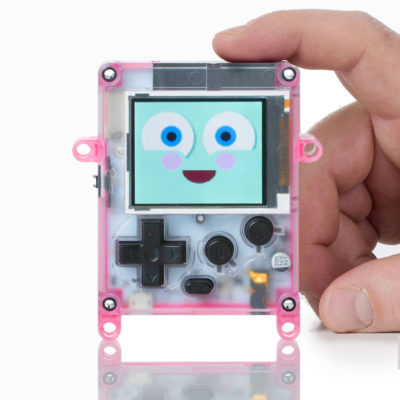Page 1 of 2
X16 Pocket Lite (fpga)
Posted: Thu Jan 14, 2021 12:26 pm
by Matej
What about. Downgraded X16 with little LCD. Only VERAlite with one fixed LCD resolution for gfx, VERA sound. SD card. DPad, fire, menu button. Smallest as possible. Ideal into pocket. With 3d printed or molded case. Gameboy was Z80. This will be true 6502 game handheld. With cartridge pins for home projects like arduino. For Commodore, Atari, NES, Apple2 fans... Also chipmusic, pixelart, retrogames, manga/anime fans etc.
Little inspiration ARM cpu POKITTO:

X16 Pocket Lite (fpga)
Posted: Thu Jan 14, 2021 1:22 pm
by John Chow Seymour
A Phase 4? The 'X16h'? (since p for pocket is already taken, maybe h for handheld)
X16 Pocket Lite (fpga)
Posted: Thu Jan 14, 2021 2:29 pm
by StephenHorn
VERA already has one fixed resolution. ? 640x480.
But once the X16p/c/e line is out, if they do well enough, I could see value in modding the FPGA code to remove various bits that a handheld wouldn't need, and whatnot.
X16 Pocket Lite (fpga)
Posted: Thu Jan 14, 2021 6:12 pm
by Lorin Millsap
This effectively nerfs most of the reasons for the X16s existence.
Sent from my iPhone using Tapatalk
X16 Pocket Lite (fpga)
Posted: Thu Jan 14, 2021 6:14 pm
by lamb-duh
4 hours ago, StephenHorn said:
VERA already has one fixed resolution. ? 640x480.
But once the X16p/c/e line is out, if they do well enough, I could see value in modding the FPGA code to remove various bits that a handheld wouldn't need, and whatnot.
Doesn't vera have 320x240 modes?
X16 Pocket Lite (fpga)
Posted: Thu Jan 14, 2021 6:20 pm
by m00dawg
5 minutes ago, lamb-duh said:
Doesn't vera have 320x240 modes?
It does but the actual signal output is still 640x480. I'm not sure sure how the analog output works in this regards (important for "scanlines"). If using a VGA monitor though, the 320x240 modes are basically pixel doubled with 640x480 output.
X16 Pocket Lite (fpga)
Posted: Thu Jan 14, 2021 8:21 pm
by SlithyMatt
1 hour ago, m00dawg said:
I'm not sure sure how the analog output works in this regards (important for "scanlines")
NTSC video from composite or S-Video will both be interlaced, meaning that 640x480 at 60Hz is not going to really work without progressive scan. 320x240 should look ok after interlacing.
X16 Pocket Lite (fpga)
Posted: Thu Jan 14, 2021 8:41 pm
by m00dawg
18 minutes ago, SlithyMatt said:
NTSC video from composite or S-Video will both be interlaced, meaning that 640x480 at 60Hz is not going to really work without progressive scan. 320x240 should look ok after interlacing.
As I recall NES/SNES and most consoles of the day were interlaced so this should give a similar look and feel for them right? If so, while I am on the lookup for a VGA CRT, running the X16 on a TV or Sony PVM will be quite a treat!
X16 Pocket Lite (fpga)
Posted: Thu Jan 14, 2021 8:52 pm
by StephenHorn
2 hours ago, Lorin Millsap said:
This effectively nerfs most of the reasons for the X16s existence.
Sent from my iPhone using Tapatalk
Sure, I just figure if there's enough uptake of the platform and interest in gamedev specifically, after all is said and done with the planned sequence of hardware revisions, and if the FPGA code is released to the public, a mobile unit that was dedicated to gaming could be cute. But with more buttons than the POKITTO. And ROM changes to list files on an SD Card, choose one via D-pad and buttons, and then do the associated LOAD and RUN. Community can totally hop on that by that point, and do the fundraising to pay you guys for the time spent creating an official ROM mod for the Petty Officer X16. (Ensign X16? Yeoman X16? Will have to think of a name.)
X16 Pocket Lite (fpga)
Posted: Thu Jan 14, 2021 9:02 pm
by StephenHorn
13 minutes ago, m00dawg said:
As I recall NES/SNES and most consoles of the day were interlaced so this should give a similar look and feel for them right? If so, while I am on the lookup for a VGA CRT, running the X16 on a TV or Sony PVM will be quite a treat!
In theory, the X16 will retain a 640-wide display, whereas the SNES was 256x224. It's just that the interlacing is drawing half the 480 scanlines per frame - evens on one frame, odds on the other.
So, again in theory, you could probably play with classic NTSC tricks for color-blending and transparency by alternating what's visible between any two frames, either by keeping your own count or by referring to the top bit of the DC_VIDEO register on the VERA. Of course, you can still do that with 320x240, and if you're doing multimedia then you're probably in 320x240 anyways just because 640x480 requires prohibitive quantities of memory in many cases.
